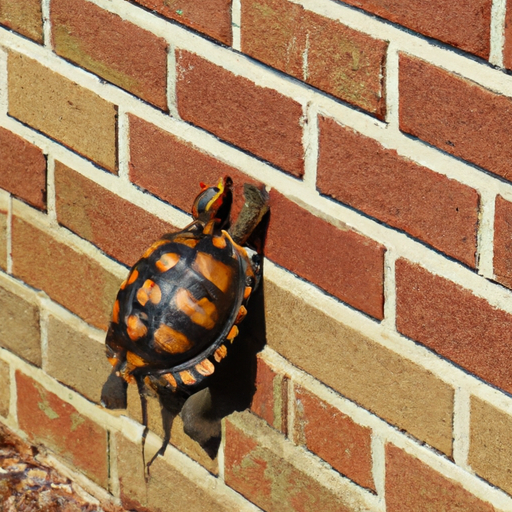Imagine witnessing the astonishing sight of a turtle effortlessly scaling walls. It sounds almost unbelievable, doesn’t it?
Well, in this article, we will explore the fascinating abilities of turtles and answer the burning question, “Can turtles climb walls?”
Prepare to be enlightened as we delve into the world of these remarkable creatures and uncover their surprising climbing skills.

Can Turtles Climb Walls
When you think of turtles, you probably imagine them slowly crawling on the ground or swimming gracefully in the water.
But have you ever wondered if turtles can climb walls? In this article, we will explore the fascinating world of turtle anatomy and their climbing capabilities.
We will also delve into the different adaptations that allow turtles to climb, as well as the factors that affect their ability to do so.
So, let’s dive in and uncover the truth about whether turtles can indeed climb walls!
Understanding the Anatomy of Turtles
In order to understand whether turtles can climb walls, we first need to explore their anatomy. Turtles have a unique structure that sets them apart from other reptiles. Their most striking feature is their protective shell, which consists of two parts: the carapace (upper shell) and the plastron (lower shell). The shell is made up of bony plates covered in a layer of keratin, which provides strength and protection.
The limb structure of turtles plays a crucial role in their locomotion and climbing abilities. Turtles have four limbs, each equipped with sharp claws that allow them to navigate various terrains. Their limbs are also flexible, which enables a wide range of movements. Additionally, turtles possess strong muscles that provide the necessary strength for climbing.
Climbing Capabilities of Turtles
While turtles are not natural climbers like other animals such as squirrels or monkeys, they do have some climbing capabilities. However, their climbing abilities are limited compared to animals specifically evolved for climbing. Turtles are primarily adapted for a life on land or in water, and their climbing skills are generally restricted to navigating small obstacles rather than scaling vertical surfaces.
Adaptations for Climbing
Although turtles are not expert climbers, they have certain adaptations that aid them in climbing. One adaptation is their sharp claws, which they use to grip onto surfaces while navigating obstacles. These claws are particularly useful for semi-aquatic turtles that often encounter climbing challenges in their natural habitats.
Flexible limbs also contribute to a turtle’s climbing abilities. The ability to extend and retract their limbs enables turtles to adapt to different surfaces and positions. This flexibility is especially beneficial for turtles when trying to navigate uneven surfaces or obstacles.
Gripping strength is another adaptation that allows turtles to climb. Their muscular limbs, combined with the sharp claws, give turtles the ability to hold onto surfaces securely. This gripping strength is important for both semi-aquatic turtles and those living in terrestrial environments.
Wall Climbing in Semi-Aquatic Turtles
Semi-aquatic turtles, as the name suggests, spend a significant amount of time both in water and on land. These turtles, including species like red-eared sliders and painted turtles, have adapted to live in diverse habitats such as marshes, ponds, and streams. While their climbing abilities may not be as advanced as arboreal animals, semi-aquatic turtles can still climb walls to a certain extent.
These turtles typically prefer habitats with gentle slopes or low-lying structures that they can easily maneuver. When faced with a wall-like structure, such as a rock or tree trunk, semi-aquatic turtles rely on their sharp claws and gripping strength to climb. By using a combination of limb movements and claw positioning, they are able to ascend relatively smooth surfaces.
Wall Climbing in Box Turtles
Box turtles are a terrestrial species known for their ability to retract their head, legs, and tail, effectively closing their shell “box.” While they may not seem like natural climbers at first, box turtles have some interesting climbing behaviors.
Box turtles are generally found in woodland areas and are frequently encountered near fallen logs or low walls. Unlike semi-aquatic turtles, box turtles are not adapted for climbing high surfaces. However, they are adept at climbing small walls or obstacles that are within their reach. Their limb flexibility and gripping strength play crucial roles in their climbing techniques.
Wall Climbing in Tortoises
Tortoises, unlike their turtle counterparts, are exclusively terrestrial creatures. They are known for their large and heavy shells, which provide excellent protection against predators. Due to their larger size and weight, tortoises are generally not considered natural climbers. They lack the limb flexibility and agility that other turtle species possess.
While tortoises may occasionally encounter low walls or slopes in their environments, their ability to climb such structures is limited. They rely more on their slow and steady pace on land rather than ascending to higher ground. It is important to note that tortoises have different climbing capabilities compared to other turtle species.
Factors that Affect a Turtle’s Ability to Climb Walls
Various factors can influence a turtle’s ability to climb walls. Understanding these factors is crucial when assessing a turtle’s climbing capabilities. Some of the factors include:
- Species: Different turtle species have varying adaptations and natural behaviors. This can impact their climbing abilities, with some species having more climbing skills than others.
- Size and Weight: Larger and heavier turtles, such as tortoises, are generally less equipped to climb walls due to their size and weight. Smaller turtles may have better climbing capabilities in comparison.
- Age: Younger turtles may be more agile and flexible, making them better climbers than older turtles. As turtles age, their climbing abilities may decrease due to slower movement and reduced muscle strength.
- Health and Fitness: A turtle’s overall health and fitness can influence its climbing abilities. Turtles that are unhealthy or have physical limitations may struggle with climbing walls.
- Environmental Factors: The presence of suitable climbing surfaces or obstacles in a turtle’s natural habitat can affect its climbing skills. Turtles that have not been exposed to climbing structures may have a harder time climbing walls when encountered.
Training Turtles to Climb Walls
While turtles possess some natural climbing abilities, it is possible to train them to become better climbers. If you are interested in teaching your turtle to climb walls, there are a few approaches you can take.
Positive reinforcement is a crucial aspect of turtle training. By rewarding your turtle with treats or praise whenever it successfully climbs a wall, you can encourage and reinforce the desired behavior. It is important to be patient and consistent throughout the training process.
Creating a climbing environment is also important for training turtles. Introduce various climbing surfaces, such as rocks, logs, or textured walls, in their enclosure. This will provide opportunities for your turtle to practice its climbing skills and develop its abilities further.
Safety Concerns for Turtles Climbing Walls
While turtles may have some climbing capabilities, it is essential to consider their safety when attempting to climb walls. Turtles can easily injure themselves if they fall from a height or get stuck in a precarious position. Ensure that the climbing surfaces are secure and sturdy to minimize the risk of accidents. Supervise your turtle closely during climbing activities and provide a safe environment to prevent any harm.
Final Thoughts
In conclusion, turtles do have some climbing capabilities, although their skills are generally limited.
Adaptations such as sharp claws, flexible limbs, and gripping strength enable turtles to navigate small obstacles and surfaces.
While semi-aquatic turtles and box turtles may exhibit climbing behaviors, their abilities to climb walls are generally restricted to low structures within their reach.
Tortoises, on the other hand, are not well-suited for climbing due to their size and weight.
Various factors, including species, size, age, health, and environmental factors, can influence a turtle’s ability to climb walls.
If you wish to train your turtle to climb, positive reinforcement and a suitable climbing environment are crucial aspects of the training process.
Safety should always be a top priority when allowing turtles to engage in climbing activities.
While turtles may not be the most adept climbers, they have evolved to thrive in their natural habitats both in water and on land.
Their unique anatomical features and climbing adaptations contribute to their overall success and survival.
So, the next time you see a turtle, you can appreciate its abilities, whether it’s crawling on the ground, swimming in the water, or navigating small climbing challenges!




